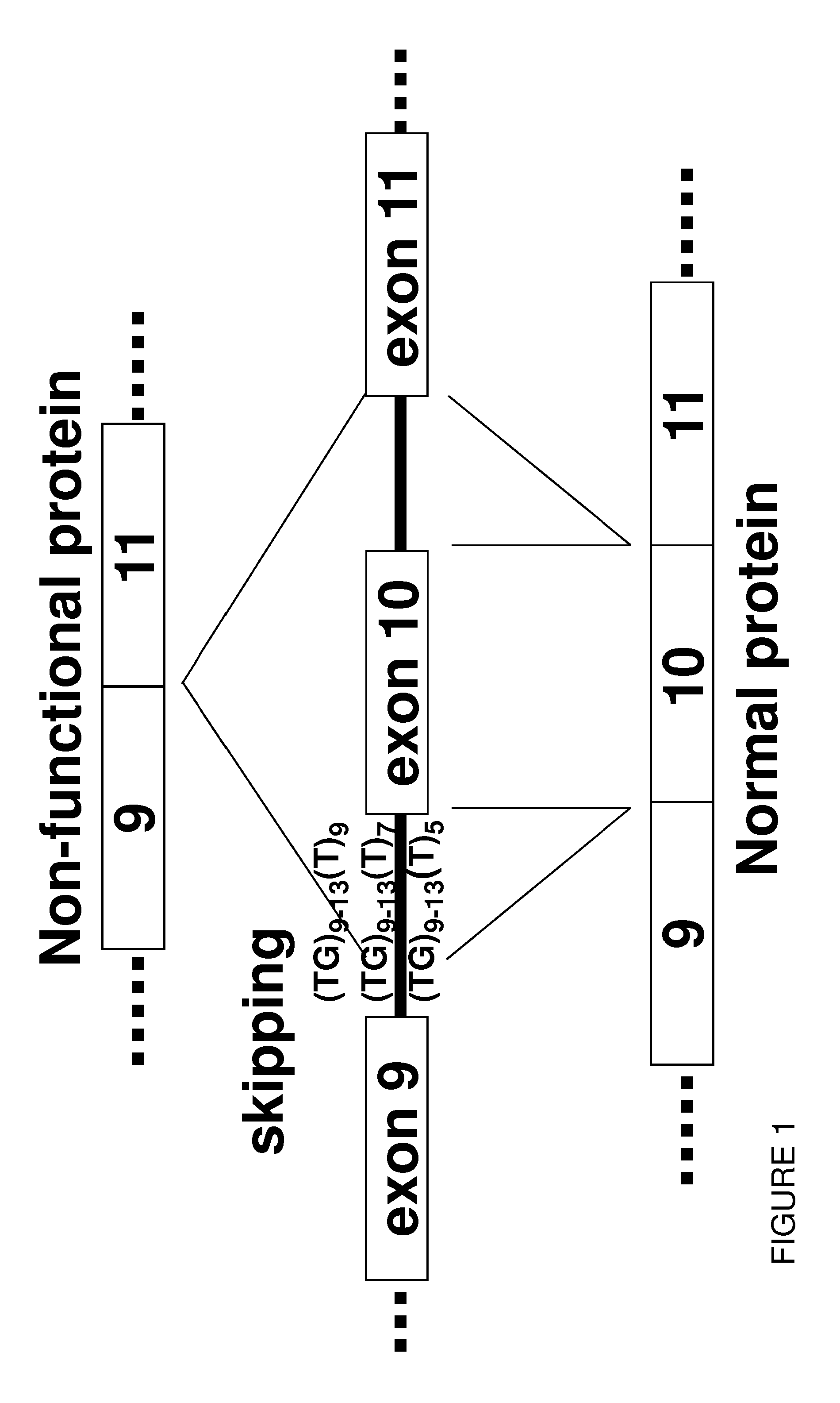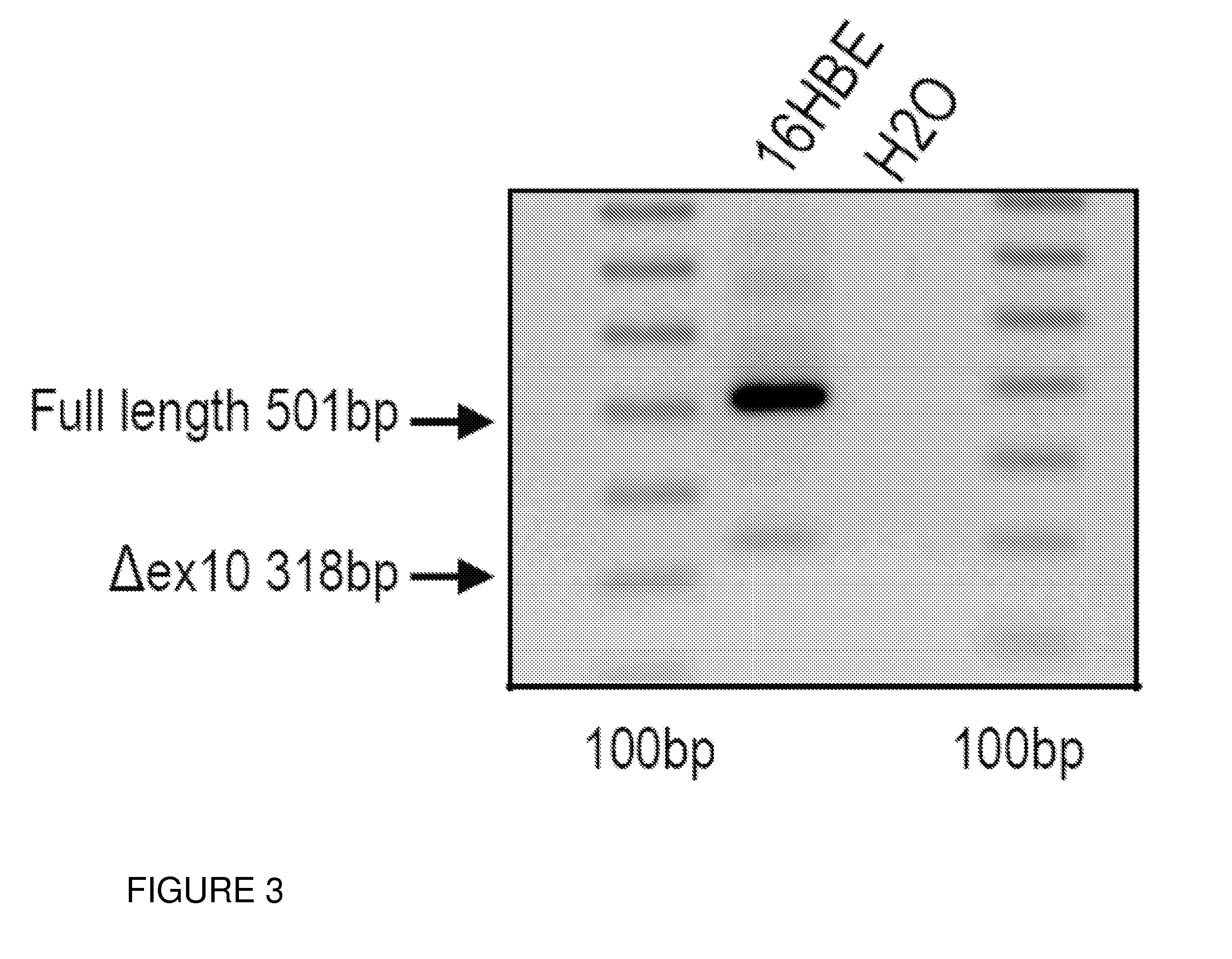Restoration Of The CFTR Function By Splicing Modulation
a cftr and splicing technology, applied in the field of oligonucleotides, can solve the problems of general reduction of quantity, and achieve the effect of restoring or enhancing the function of the cftr gene product, modulating splicing, and avoiding improper skipping of canonical exons
- Summary
- Abstract
- Description
- Claims
- Application Information
AI Technical Summary
Benefits of technology
Problems solved by technology
Method used
Image
Examples
example 1
[0116]Oligonucleotide No. 5 was synthesized and tested for its anti-splicing-silencing capability, i.e. its ability to minimize exon 10 skipping and increase exon 10 inclusion in the mature CFTR mRNA in 16HBE cells (see FIG. 3). FIG. 4 depicts that oligonucleotide no. 5 was indeed able to dramatically increase the level of exon 10 inclusion in the mature CFTR mRNA in a dose dependent manner, as clearly evident from the progressive strengthening of the full 501-base transcripts and the progressive weakening and eventually loss of the aberrant Δ exon 10 318-base transcripts.
[0117]The data presented in FIG. 4 provides substantial evidence, for the first time, that exon 10 splicing may be modulated by oligonucleotides targeting sequences within and adjacent to exon 10 (as illustrated in FIG. 2).
example 2
[0118]Epithelial cell line CFP15a, established from a nasal polyp of a Cystic Fibrosis patient carrying the 3849+10 kb C to T splicing mutation, were transfected with various concentrations of oligonucleotides 1-4 as described above (see FIG. 7). After 4 hours of incubation, the transfected medium was replaced with fresh medium. Twenty four hours after transfection, the cells were harvested for RNA extraction, followed by cDNA synthesis. Aliquots of cDNA were used for RT-PCR using two pairs of outer primers towards exon 22 and the 84 bp cryptic exon (primers 5-6 in Table 3) and towards exon 26-27 (for total CFTR evaluation, primers 1-2 in Table 3). Nested PCR was subsequently performed using internal primers (primers 7-8 for the detection of the 84 bp cryptic exon, and primers 3-4 for the evaluation of total CFTR level). FIG. 8A depicts that oligonucleotides 1-4 completely prevented the formation of the CFTR 84 bp splicing variant in the transfected cells in both concentrations (25 ...
example 3
[0120]In addition to the experimental results provided in Example 2, CFP15a epithelial cells were transfected with oligonucleotide 4 for 24 hours (transfection concentration: 10 nM). Following transfection, the cells were analyzed for functional CFTR activity using the halide efflux assay (SPQ). Following treatment, a significant restoration of the CFTR protein activity was observed. The extent of fluorescence is correlated with CFTR channel activation. FIG. 9 depicts that as soon as 24 hours post oligonucleotide 4 transfection, functional CFTR chloride channels responsible for chloride transport were embedded in the epithelial cells' membrane resulting in restored CFTR function.
[0121]To further verify this result, forskolin and genestein (CFTR channel activators) were added, since their addition, pending that the CFTR channel is present on the cell membrane and is functional, will cause the channel to open and allow chloride efflux. FIG. 9 depicts that the fluorescent signal has in...
PUM
| Property | Measurement | Unit |
|---|---|---|
| concentration | aaaaa | aaaaa |
| conductance | aaaaa | aaaaa |
| chloride conductance | aaaaa | aaaaa |
Abstract
Description
Claims
Application Information
 Login to View More
Login to View More - R&D
- Intellectual Property
- Life Sciences
- Materials
- Tech Scout
- Unparalleled Data Quality
- Higher Quality Content
- 60% Fewer Hallucinations
Browse by: Latest US Patents, China's latest patents, Technical Efficacy Thesaurus, Application Domain, Technology Topic, Popular Technical Reports.
© 2025 PatSnap. All rights reserved.Legal|Privacy policy|Modern Slavery Act Transparency Statement|Sitemap|About US| Contact US: help@patsnap.com



